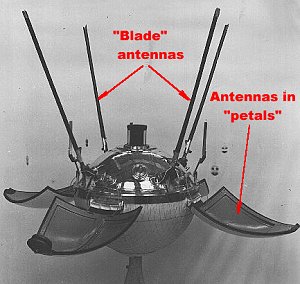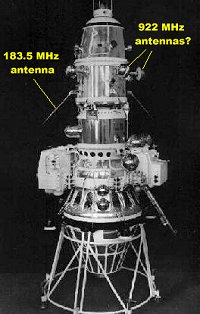 It
is well known that the Luna 9 and 13 lander capsules transmitted
signals
from the Moon's surface on 183.538 MHz (1)
and also en route. The telemetry and picture transmissions on this
frequency
were phase-modulated on the carrier (1).
It
is well known that the Luna 9 and 13 lander capsules transmitted
signals
from the Moon's surface on 183.538 MHz (1)
and also en route. The telemetry and picture transmissions on this
frequency
were phase-modulated on the carrier (1).
It is not possible to find the antennas for this frequency on the spacecraft "bus". On the lander capsule itself there are antennas of two kinds (see picture on the left): One installed on the inside of the "petals" that unfolded upon landing and one type that consisted of four blade antennas that were deployed after the "petals" opened. It is unclear whether or not the lander version of the spacecraft carried any 922 MHz transmitters.
The frequency of the landing radar for Luna 9 & 13 was 3.2 cm, i.e. ~ 9.4 GHz (5). The landing radar antenna is easy to identify. It is a small dish pointing in the direction of descent.
 All
Luna orbiters in this series (Luna 10,11,12 & 14) were also
observed
to transmit on 183.5 MHz (2) (3)(5).
At 1944-1950 UT on 3 April 1966, the Luna 10 spacecraft transmitted
"The
International" (37 kB mp3) on
183.535 MHz (3).
All
Luna orbiters in this series (Luna 10,11,12 & 14) were also
observed
to transmit on 183.5 MHz (2) (3)(5).
At 1944-1950 UT on 3 April 1966, the Luna 10 spacecraft transmitted
"The
International" (37 kB mp3) on
183.535 MHz (3).
One source also says that Luna 10 had a 922 MHz transmitter (4). On Luna 10 the antennas for 183.5 MHz are easy to find (see picture at right) and probably the four hemispherical-looking antennas around the orbiter are intended for 922 MHz. The antennas are mounted on the "orbiter" and not on the "bus"!
There are two pictures of mock-ups of the Luna 10 orbiter and the four hemispherical antennas around the "waist" of the orbiter look different in the two pictures. In one the antenna is a hemisphere with a tapered slot on its surface and in the other the antenna is a hemispherical spiral! (Check Alexander Chernov's Virtual Space Museum).
On pictures of the Luna 12 and 14 craft a conical helix is clearly visible which in all certainty is the antenna for the 922 MHz downlink and the 768 MHz uplink.
"...Three modes of operation of the probe are possible: (1) the transmitter operates on a constant frequency, (2) the transmitter is locked in frequency to a signal emitted from the Earth at a constant frequency, and (3) as in the previous case, but the signal from the Earth is also varied in frequency. ........ Transmissions of a steady carrier were rare, the transmitter was turned off for much of the time, and at other times a rapidly sweeping frequency was transmitted, presumably as a means of measuring the distance of the probe from the Earth...... "
The description of the third mode of operation seems to be similar to the ranging frequency sweeps on 183.5 MHz observed by myself from the Luna 20 return craft.(See "Reception of signals on 183.54 MHz from the Luna 20 return spacecraft in Stockholm"). This is probably the standard ranging system used from the days of Luna 1. (See "The radio systems of the early Luna probes").